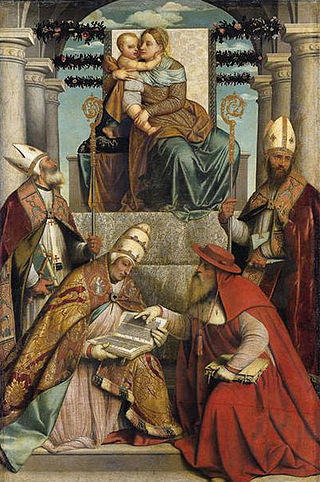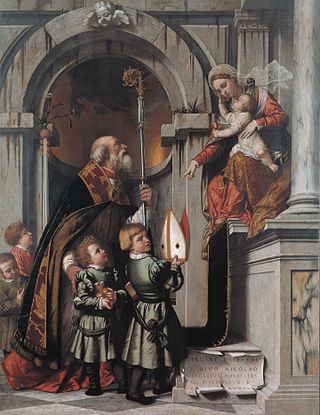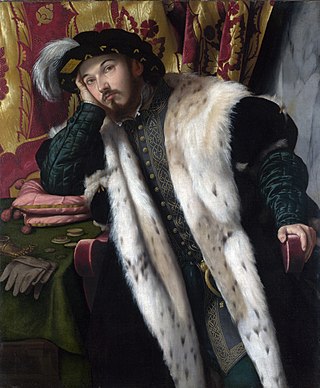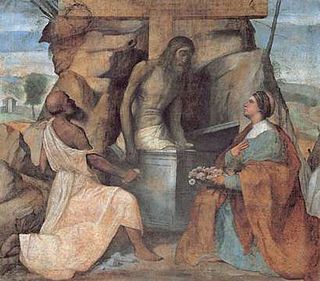
Salomé is an oil painting on canvas, by Moretto da Brescia, executed c. 1540. It is kept in the collection of the Pinacoteca Tosio Martinengo in Brescia.

Pentecost is an oil on canvas painting by Moretto da Brescia, executed c. 1543–1544, originally painted for San Giuseppe Church in Brescia and now in the city's Pinacoteca Tosio Martinengo.

Assumption of the Virgin is a 1524–1526 oil on canvas painting by Moretto da Brescia, displayed as the high altarpiece in the Old Cathedral in Brescia.

The Deaf-Mute Filippo Viotti's Vision of the Virgin Mary is an oil on canvas painting by Moretto da Brescia, executed c. 1534, displayed in the Santuario della Madonna at Paitone in the Province of Brescia, Italy. It is first recorded in 1648 by Carlo Ridolfi, who wrote that "in the church atop Monte Paitone one can still admire a miraculous image of the Virgin which Moretto made at the request of that town for such a miracle".

Lament over the Dead Christ is a 1526–1530 oil on canvas painting by Moretto da Brescia, now in the National Gallery of Art in Washington. Painted late in the painter's youth, it shows strong similarities to the central panel of Paolo Caylina the Younger's Deposition Altarpiece from around the same time, though there are also notable differences in their use of color, such as the brighter and clearer colors used by Moretto. Some of the elements reused by Moretto in Lament recurred later in his career, so the work gives a clear idea of Moretto's training and education as an artist.

Enthroned Madonna and Child with Saint James the Great and Saint Jerome is a c.1517 oil on canvas painting by Moretto da Brescia, now in the High Museum of Art in Atlanta, which acquired it in 1950. It is one of the painter's earliest known works.

Madonna and Child with Saint Roch and Saint Sebastian is an oil on canvas painting on one of the side altars of the church of Sant'Andrea in Pralboino, province of Brescia, Italy. It was executed c. 1528 by Moretto da Brescia.

Madonna and Child with Four Doctors of the Church is a 1540-1545 oil on canvas painting by Moretto da Brescia, now in the Städelsches Kunstinstitut in Frankfurt. From left to right it shows Saint Ambrose, Gregory the Great, Saint Jerome and Augustine of Hippo.

Madonna and Child with Saint Martin and Saint Catherine is an oil on canvas painting by Moretto da Brescia, executed c. 1530, now on the high altar in the church of San Martino in Porzano, Province of Brescia. It is the painter's first mature work and forms an important step towards his Coronation of the Virgin Altarpiece.

Our Lady of Mount Carmel is a painting in oils on canvas by Moretto da Brescia, executed c. 1522 and now in the Gallerie dell'Accademia in Venice. It arrived in the Accademia's collection in exchange for two paintings sent to the Tempio Canoviano in Possagno. The painting is one of the most notable works of the artist's youth. Its original location is unknown as the first confirmed written record of the work dates to the 19th century. It was probably in the Confraternity of Our Lady of Mount Carmel's altar in Santa Maria del Carmine church in Brescia; a reference to a "large canvas ... something of a large study in the hand of Moretto" in Bernardino Faino's 1630 guide to Brescian art may be to this work.

Madonna and Child Enthroned with Saints is a 1536-1537 oil on canvas painting by Moretto da Brescia, now on one of the side altars in the church of Sant'Andrea in Bergamo.

The Orzinuovi Altarpiece or Enthroned Madonna and Child with Saints Dominic, Joseph, Vincent Ferrer, Lucy and a Commissioner is a 1525–1530 oil on canvas painting by Moretto da Brescia on the wall of the chancel of the church of San Domenico in Orzinuovi.

The Pralboino Altarpiece is an oil on canvas altarpiece, of 1540–1545 and measuring 356 x 225 cm, by Moretto da Brescia in the church of Sant'Andrea in Pralboino, Province of Brescia, Italy. The work's upper register shows the Madonna and Child with Francis of Assisi and Saint Joseph, whilst below are saints Jerome, Louis of Toulouse, Anthony of Padua, Clare of Assisi and the painting's commissioner, cardinal Uberto Gambara, member of a local family. It was originally in the same town's Franciscan church of Santa Maria degli Angeli.

The Luzzago Altarpiece is a 1542 oil on canvas painting by Moretto da Brescia, now in the Pinacoteca Tosio Martinengo in Brescia. It was recorded in San Giuseppe church in Brescia in 1630 and moved to its present home in 1868. In the lower register Michael the Archangel points the kneeling donor to the Madonna and Child above, whilst Francis of Assisi stands to the right with a cross.

The Rovelli Altarpiece is a 1539 oil on canvas painting by Moretto da Brescia, which since 1899 has been in the Pinacoteca Tosio Martinengo in Brescia, Italy. Strongly influenced by Titian, it is named after the schoolmaster Galeazzo Rovelli who commissioned it for the church of Santa Maria dei Miracoli in Brescia in 1539, where it remained until being removed in the 19th century and replaced by a copy. Its composition was reused by Moroni in his Mystic Marriage of Saint Catherine in the 1560s.

Portrait of Fortunato Martinengo Cesaresco is a 1542 oil on canvas painting by Moretto da Brescia, now in the National Gallery, London. The use of X-ray photography during a 1973 restoration showed a table in front of the man with an open book on it.

St Antony the Abbot is a 1530-1534 oil on canvas painting of Antony the Great by Moretto da Brescia on display on one of the side-altars in the Santuario della Madonna della Neve in Auro, Casto, Province of Brescia, Italy.

St Justina of Padua with a Donor is an oil on panel painting by Moretto da Brescia, executed c. 1530, now in the Kunsthistorisches Museum in Vienna, to which it was transferred in the late 19th century soon after the museum's opening. It shows Justina of Padua.

The Dead Christ Adored by Saint Jerome and Saint Dorothy or Saint Jerome and Saint Dorothy Adoring Christ in the Tomb is a 1520-1521 tempera verniciata on canvas painting by Moretto da Brescia. It is on show above the left-hand side door to the church of Santa Maria in Calchera in Brescia, though it is not thought to have originally been produced for that church as neither Jerome nor Dorothy had an active cult in that parish and they rarely appear in art together.

Massacre of the Innocents is an altarpiece oil painting by Moretto da Brescia, executed in 1531–1532, originally painted on panel but later transferred to canvas. It is on display on a side altar in San Giovanni Evangelista church in Brescia.





















